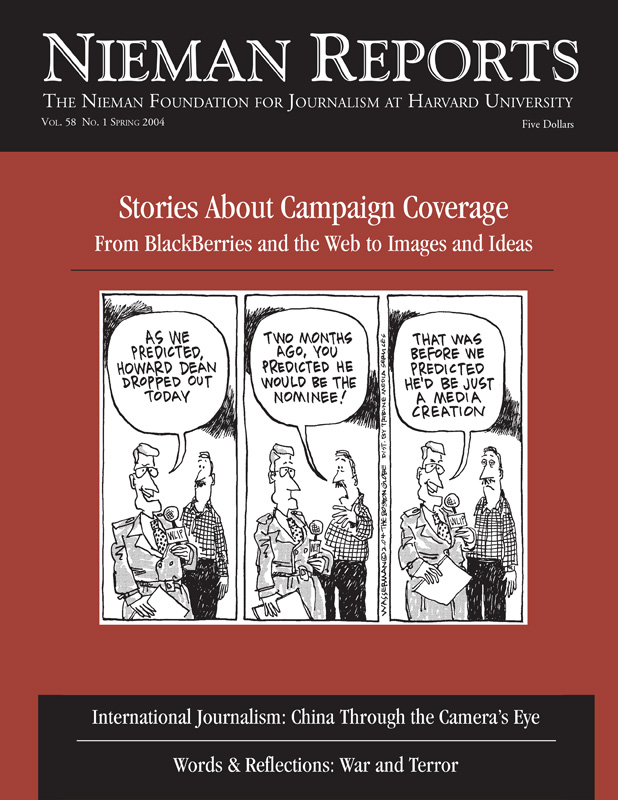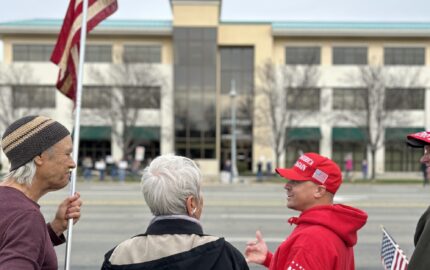
Stories About Campaign Coverage
In his essay “Only a Lunatic Would Do This Kind of Work,” David M. Shribman, executive editor of the Pittsburgh Post-Gazette, captures the essence of what motivates political journalists. “They have an ethos,” Shribman writes. “They believe in inquiry. They believe in the value of the pointed question. They believe in catching their prey in an unscripted moment or in a lie. They believe in asking impertinent questions of their social betters. They believe small deviations from a candidate’s basic stump speech have grave implications.” – Melissa Ludtke, Editor
Money, ads, staff and calendar. Those themes dominate much of political journalism in the months before a presidential election cycle really kicks in. And they are pushed by reporters acting as horserace handicappers, trying to determine the main contenders and which candidates have what it takes to win the nomination and even the fall election.
It’s a kind of “supply-side” approach to political reporting. Figure out who has the most money, the cleverest commercials, the most seasoned operatives, the advantages of early caucus and primary dates—and reporters have the data they think they need to predict likely winners.
This approach sounds reasonable, but I would argue it usually leads the best and the brightest of political journalists down a blind alley, somewhere in Des Moines, Iowa or Manchester, New Hampshire. What ought to replace this customary campaign coverage is a “demand-side” model that begins analysis by focusing on concerns voters feel should be addressed and framing stories with an understanding of what fuels voters’ passions.
The handicapping role of political journalists, while it might not be as important as their civic education responsibilities to readers, viewers and listeners, is more than just an exercise in amusing political junkies. Smart analysis of which candidates are connecting with voters and why helps determine whether the press pack affords too much ink and airtime to those who aren’t striking a responsive chord and too little to those who are.

Senator Joseph Lieberman entering the “spin room” following the January 22, 2004 debate held in New Hampshire at St. Anselm’s College. Photo by © Meryl Levin.
A Plethora of Irrelevant Reporting
When one considers the confluence of players in the tiny echo chamber where political information gets exchanged—political reporters and columnists, operatives, fundraisers and gossip regurgitation conduits like The Hotline and the cable-babble networks—it is easy to see how political journalism gets bogged down in misleading insiders’ minutia.
Take the topic of campaign money, for example. The Washington, D.C. ethics industry, which regards dollars as the root of all electoral and governance evil, provides easy story lines for skeptical-to-cynical reporters. A quick stop at the Federal Election Commission Web site gave reporters “proof” in mid-2003 that Senators John Kerry and John Edwards might be the top contenders for the nomination simply because each had piled up lots of cash. And conversely, journalists sent out the message that a little-known former governor of an unimportant little state had little chance of connecting with voters because he wouldn’t be able to raise money.
Journalists’ obsession with “following the money” begets the kind of misleading reporting that touted the prospects of a President John Connolly in 1980 and a President Phil Gramm in 1996. History tells us that Connolly and Gramm were both candidates who quickly failed to convince voters of their inevitability and whose money couldn’t buy an attractive message. Yet history repeats as money-obsessed reporters refuse to learn a simple truth: Message is what attracts money, not the other way around. A strong connection with supporters allowed Dean to raise $40 million; John Kerry mortgaged his house to fund his Iowa campaign.
In this election cycle reporters have also supplied us with an orgy of stories that focused on commercials, staff and calendar—on such inconsequential events as a Gephardt-friendly independent expenditure group’s nasty attack ad against Howard Dean; a week or so of pack journalistic attention to Kerry firing his campaign manager, Jim Jordan, and the rules-junkie gotcha’ reporting about Democratic National Committee Chairman Terry McAuliffe’s minor tinkering with the party’s primary and caucus calendar. However, the truth is that the attack ad neither helped Gephardt nor hurt Dean; Kerry’s campaign manager had nothing to do with the candidate’s failure to connect with voters early in the process, and show me one time national party rules or the order of delegate selection contests has ever changed the outcome of a nomination battle.
While these kinds of stories were probably interesting to insiders, it’s disheartening how little of a window they opened to how the race for the Democratic nomination was really shaping up in 2003. Comparable story lines failed to produce useful insights during other election walk-up years, when Jimmy Carter, Gary Hart, and Bill Clinton were pulling surprise ascents like Dean’s, which seasoned reporters remained all but blind to before they became too obvious to ignore.
Beginning instead with the voters—learning about their lives, desires and concerns—rather than harping on campaign tactics seems a better direction in which to head. In covering primary campaigns, in particular, I would suggest that journalists gear their reporting to assessing four key factors, which I call base, biography, edge and effort.
Covering the General Election Campaign
There are a similar set of tools reporters can use to assess general election presidential campaigns: They are what I call party, personality, times and tactics. (By “times,” I mean the issue environment in which the race is taking place.) Here are some questions worth keeping in mind:
Base, biography, edge and effort in primary campaign coverage. Party, personality, times and tactics when reporting on the general election. These are not brilliant intellectual constructs, but they are better indicators for journalists to use when letting voters know which candidates are viable contenders than the current focus on raising money, running ads, hiring and firing staff, and insider nonsense like the order of primaries and caucuses.
Terry Michael is executive director of the Washington Center for Politics & Journalism, where he runs The Politics & Journalism Semester to teach college journalists about politics. He is a former press secretary for the Democratic National Committee (1985-87) and communications director for the 1988 Paul Simon for President campaign.
It’s a kind of “supply-side” approach to political reporting. Figure out who has the most money, the cleverest commercials, the most seasoned operatives, the advantages of early caucus and primary dates—and reporters have the data they think they need to predict likely winners.
This approach sounds reasonable, but I would argue it usually leads the best and the brightest of political journalists down a blind alley, somewhere in Des Moines, Iowa or Manchester, New Hampshire. What ought to replace this customary campaign coverage is a “demand-side” model that begins analysis by focusing on concerns voters feel should be addressed and framing stories with an understanding of what fuels voters’ passions.
The handicapping role of political journalists, while it might not be as important as their civic education responsibilities to readers, viewers and listeners, is more than just an exercise in amusing political junkies. Smart analysis of which candidates are connecting with voters and why helps determine whether the press pack affords too much ink and airtime to those who aren’t striking a responsive chord and too little to those who are.

Senator Joseph Lieberman entering the “spin room” following the January 22, 2004 debate held in New Hampshire at St. Anselm’s College. Photo by © Meryl Levin.
A Plethora of Irrelevant Reporting
When one considers the confluence of players in the tiny echo chamber where political information gets exchanged—political reporters and columnists, operatives, fundraisers and gossip regurgitation conduits like The Hotline and the cable-babble networks—it is easy to see how political journalism gets bogged down in misleading insiders’ minutia.
Take the topic of campaign money, for example. The Washington, D.C. ethics industry, which regards dollars as the root of all electoral and governance evil, provides easy story lines for skeptical-to-cynical reporters. A quick stop at the Federal Election Commission Web site gave reporters “proof” in mid-2003 that Senators John Kerry and John Edwards might be the top contenders for the nomination simply because each had piled up lots of cash. And conversely, journalists sent out the message that a little-known former governor of an unimportant little state had little chance of connecting with voters because he wouldn’t be able to raise money.
Journalists’ obsession with “following the money” begets the kind of misleading reporting that touted the prospects of a President John Connolly in 1980 and a President Phil Gramm in 1996. History tells us that Connolly and Gramm were both candidates who quickly failed to convince voters of their inevitability and whose money couldn’t buy an attractive message. Yet history repeats as money-obsessed reporters refuse to learn a simple truth: Message is what attracts money, not the other way around. A strong connection with supporters allowed Dean to raise $40 million; John Kerry mortgaged his house to fund his Iowa campaign.
In this election cycle reporters have also supplied us with an orgy of stories that focused on commercials, staff and calendar—on such inconsequential events as a Gephardt-friendly independent expenditure group’s nasty attack ad against Howard Dean; a week or so of pack journalistic attention to Kerry firing his campaign manager, Jim Jordan, and the rules-junkie gotcha’ reporting about Democratic National Committee Chairman Terry McAuliffe’s minor tinkering with the party’s primary and caucus calendar. However, the truth is that the attack ad neither helped Gephardt nor hurt Dean; Kerry’s campaign manager had nothing to do with the candidate’s failure to connect with voters early in the process, and show me one time national party rules or the order of delegate selection contests has ever changed the outcome of a nomination battle.
While these kinds of stories were probably interesting to insiders, it’s disheartening how little of a window they opened to how the race for the Democratic nomination was really shaping up in 2003. Comparable story lines failed to produce useful insights during other election walk-up years, when Jimmy Carter, Gary Hart, and Bill Clinton were pulling surprise ascents like Dean’s, which seasoned reporters remained all but blind to before they became too obvious to ignore.
Beginning instead with the voters—learning about their lives, desires and concerns—rather than harping on campaign tactics seems a better direction in which to head. In covering primary campaigns, in particular, I would suggest that journalists gear their reporting to assessing four key factors, which I call base, biography, edge and effort.
- Base: Is the base burning, or is it bored? Is it demanding big changes in policy direction, or does it just want to get out of the wilderness and end a string of defeats? In this cycle, the Democratic Party base is energized like it hasn’t been in decades by anger about the Iraq War and a Justice Department threatening (at least in the liberal imagination) individual choice and liberty. A candidate tapping into those feelings, even one from an unimportant little state like Vermont, should have been taken more seriously from the start than a bunch of members of Congress not willing to rock the status quo boat.
- Biography: How does a candidate’s past, his core beliefs and issue positions and his personal style, fit the issue environment of this race? The Vietnam era generation of reporters and editors now dominating the senior levels of American journalism quickly concluded that Vietnam veteran John Kerry possessed the magic bullet to challenge former weekend-warrior and commander in chief, George Bush. This one-dimensional assessment failed to factor in how passionately activist Democrats wanted a candidate who really did oppose the war, rather than one who might look good against Bush. Think back to the many mistakes journalists have made in the last two decades in assessing the need for Democrats to nominate a military or war hero: Annapolis graduate Jimmy Carter was defeated by silver screen warrior Ronald Reagan; space hero John Glenn was crushed in 1984 by Corporal Walter Mondale, a 1950’s Army draftee; Navy SEAL Bob Kerrey was drowned by draft-evading Bill Clinton, and Vietnam volunteer Al Gore was defeated by National Guard, Vietnam-evader George W. Bush. Biography is important in assessing viability, but mostly in judging whether a candidate appears sufficiently likeable, authentic and spontaneous, rather than whether he or she fits a simplistic stereotype. And biographical attributes that appear potentially lethal (draft evasion, womanizing, noninhaling) can be overtaken by the cognitive dissonance of voters who are willing to ignore personal questions if the person has something to offer that they believe is more important than his or her indiscretions.
- Edge: Is there enough of an edge to a candidate’s message to make it penetrate? Or is a candidate so polished that the words flow through the ears of voters without slowing down for impact? Message edge is key to understanding why congressional candidates are almost always defeated by governors. Members of Congress spend their lives in Washington talking to organized interests, using smoothly polished words full of deniability. This is done to make the National Association of This and the American Council of That each believe they are on its side. Governors, who need popular follow-ings if they are to successfully pursue policy agendas in state legislatures, are much more accustomed to speaking in language real people understand.
- Effort: If the candidate has to win a close election, has he or she put together a sufficiently strong tactical effort to do so? This is where some of the insider factors, like money and staff, are of importance. But they’re most important on the margins in tight races, when the base is unmotivated and candidates have little to say or lack the ability to use language that conveys attitude. Journalists who focus on fundraising, the creative use of new tactics like interactive, voter-mobilizing Web sites, strong field operations, and skillful campaign commercials should place such tactical considerations in broader context. By itself, this kind of reporting tells voters very little, since these tactics might be in use by a campaign whose candidate hasn’t understood what the base wants and doesn’t have the biography and the communication edge that would make them matter. In the end, flawed candidates are their own worst enemy.
Covering the General Election Campaign
There are a similar set of tools reporters can use to assess general election presidential campaigns: They are what I call party, personality, times and tactics. (By “times,” I mean the issue environment in which the race is taking place.) Here are some questions worth keeping in mind:
- Party: Is the party label an advantage for the Democrat or Republican with persuadable, independent-minded voters? Or are the parties at near parity, as they are now nationwide? This can be a big variable, and well worth watching, as the party nominees factor this in when deciding how much attention is needed to shore up their bases, as compared with trying to expand the base to reach those more casual and independent voters.
- Personality: Are the candidates’ personalities evenly matched? Or does one stand out for any particular reason? What’s important for reporters is figuring out if a candidate crosses the threshold of likeability. For example, in 2000 Bush, who often seemed bumbling, defeated Gore, who voters viewed as the class know-it-all, always trying to show how smart he was.
- Times: Is the issue environment rich? Is the nation at war? Has an incumbent been disgraced? Is inflation out of control, or are voters enjoying the calmness of peace and prosperity? The answer to this key question points the way to how voters feel about maintaining the status quo or seeking new direction. The times in which a campaign is waged—recall “it’s the economy stupid” in 1992—can drive a race with such great velocity that no brilliant countermove, such as trying to talk about Clinton’s character, can change where voters are headed.
- Tactics: Finally, we’ve arrived back at tactics. When parties are at parity and the candidates are equally boring and times are quiet, journalists can start to focus a little more on tactical advantages. Such was the case in 1988 when smart tacticians conjured up nonissues like Willie Horton, the Pledge of Allegiance, and American Civil Liberties Union to define an opponent before he defined himself. In the 2004 race, tactics may be unusually important; with each party near parity, they will have to engage in a sophisticated tactical “ground war” to mobilize and turn out their base voters. But they’ll also have to address independents and those who are leaning one way or the other, with a more strategic air campaign (consisting mostly of free media, not the paid commercials to which reporters pay far too much attention in presidential races).
Base, biography, edge and effort in primary campaign coverage. Party, personality, times and tactics when reporting on the general election. These are not brilliant intellectual constructs, but they are better indicators for journalists to use when letting voters know which candidates are viable contenders than the current focus on raising money, running ads, hiring and firing staff, and insider nonsense like the order of primaries and caucuses.
Terry Michael is executive director of the Washington Center for Politics & Journalism, where he runs The Politics & Journalism Semester to teach college journalists about politics. He is a former press secretary for the Democratic National Committee (1985-87) and communications director for the 1988 Paul Simon for President campaign.


